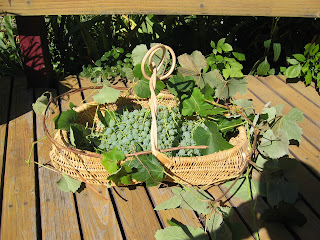Family: Brassicaceae
or Cruciferae
Genus:
Brassica
Species:
Brassica oleracea
 |
| Red cabbage "roses" interlaced with pumpkin vines |
For a new gardener, growing cabbages will make you feel
like you sprouted a green thumb overnight. They are highly productive, you can leave them hanging out in the
garden until you need one because they stay sweet without getting starchy, and they
are happy in cooler autumn weather. Also, women in Poland, who
consume large quantities of cabbage, have very low incidences of breast
cancer. And like the stork story, there is an old tale that babies come from cabbage patches. So, be on the look out for one of those.
The word
cabbage derives from the French word “caboche” which means head or noggin. I adoringly said to Bumble, “You are my little cabbage head.”
“That means I am stupid," Bumble replied.
“Well, well, well,” I said. And that is exactly what eating cabbages can make you.
“That means I am stupid," Bumble replied.
“Well, well, well,” I said. And that is exactly what eating cabbages can make you.
Here is an easy enzymatic coleslaw recipe; Bumble loved it and forgave me instantly. We
ate the slaw with these delicious Lemon Rosemary Brauts from SWEETWOOD CATTLE COMPANY, located in Steamboat Springs.
 |
| My red cabbage coleslaw |
My RED CABBAGE COLESLAW
Note: I got
lazy and used my food processor but you don't need one.
1 medium size red cabbage sliced VERY
thin. (take off the limp outer leaves and any white core)
3 or 4 organic carrots grated
1 medium apple cored and grated (I keep skins on)
3-4 T. apple cider vinegar (I use Bragg Organic Apple Cider Vinegar with the “Mother”)
3-4 T. extra virgin olive oil
1 T. soy sauce
Salt and pepper to taste.
Grate carrots and the apple, and slice
cabbage very thin. If you are using the food processor use the “grater”
attachment and cut your cabbage into a size that fits the feed tube. Add cider
vinegar, olive oil, soy sauce, salt and pepper. Toss and adjust by adding a bit more
vinegar, oil, salt and pepper if needed.












